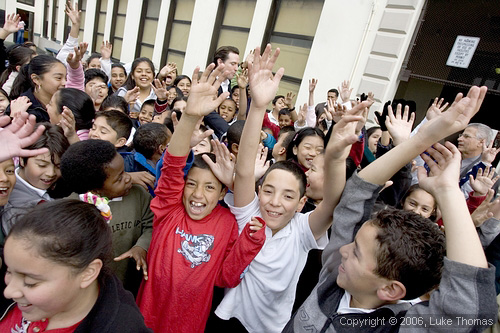
Though gentrification is understood in terms of its impacts in driving out low-income residents, impacts to education are not so well understood and have been largely ignored. File photo by Luke Thomas, 2006.
By Sean Lords
November 27, 2013
Rapid gentrification has been affecting the lives of all of San Francisco’s residents, so why has the relationship between the city’s changing population and public education been largely ignored? Gentrification can lead to schools becoming either more or less diverse, and has been used as a tool to bring “socioeconomic balance” to schools. The introduction of students from more privileged socioeconomic backgrounds can make standardized test scores appear higher for the school as a whole, thus distracting from the real issues that cause students to struggle, especially poverty.
In other gentrified cities including New York, Washington D.C., and Chicago, population shifts resulting from gentrification have led to school closures and the re-segregation of schools as wealthy families push minorities and the poor out of their neighborhood schools. In Washington D.C. it has sometimes led to organic desegregation as wealthier white students enroll in previously disinvested schools. Though often credited to corporate-style school reform, the influx of wealthier, higher-performing students skew test score statistics, making it appear as though the schools themselves are changing (and thus “improving”) as opposed to the school population. This does little to address the correlation between economic background and educational opportunities. In this way, gentrifying schools become yet another smoke screen that distracts the public’s attention from the root problem of pervasive economic inequality.
Gentrification is also noticeably affecting Oakland’s schools. At one point known as the “charter capital of California,” Oakland spent the last ten years implementing educational reform and has had little to show for it. Now, middle class families are moving to the area and working with organizations such as the Great Oakland Public Schools Learning Center, or GO, on innovative solutions to provide equitable, quality public education to Oakland’s students. According to GO, the Oakland Unified School District (OUSD) is California’s “most improved urban school district,” with some caveats—“ A majority of Oakland’s public schools struggle to equitably and excellently serve students, particularly students of color and those from socioeconomically disadvantaged or language minority backgrounds.” This suggests that the measurable improvements could be the result of shifting demographics as much as they are a result of the advocacy initiated by Oakland’s middle class population.
The cause of OUSD’s improvements is difficult to track given that while school districts keeps tabs on both the socioeconomic status (SES) and the racial/ethnic breakdown of their student populations, it does not track the intersection between the two even as the correlation may seem obvious—as it has gentrified over the last twenty years, San Francisco has seen its African American population reduce by 35.7%, according to the US Census Bureau. Additionally, achievement is more likely to be tracked by race and ethnicity as opposed to SES. In San Francisco, the SFUSD reports that they have narrowed the achievement gap between African-American and Latino students and their peers by 10-13% over five years without accounting for the change in student enrollment over that period. Even though we know that between 2008 and 2012 the SFUSD’s African-American population dropped by two percent, we know little about that two percent beyond their racial/ethnic background.
Perhaps the impact of gentrification on San Francisco’s schools has been ignored because according to mainstream metrics they haven’t been failing, while Oakland’s have. SFUSD has done better than the seven largest California school districts on the California Standards Tests (CST) for the past six years. And while the Thomas B. Fordham foundation states that San Francisco lacks “urgency” for the corporate-style reform it advocates, the SFUSD itself has received a $2.7 million dollar investment from Salesforce.com—another trickle-down benefit of San Francisco’s tech-fueled gentrification.
Ultimately, it’s difficult to tell how gentrification has affected schools in San Francisco or any other city beyond anecdotal evidence. Collecting statistics can be problematic as it is—California’s enthusiasm for the common core and standards-based report cards may give us numbers, but these numbers take student achievement out of the extracurricular contexts that influence it. Our experiences of diversity both inside and outside of the classroom effect education—as opposed to training associated with achievement on standardized tests—so it’s time that we start telling stories and paying attention to how gentrification is effecting San Francisco’s youngest residents.



 The Hunger Site
The Hunger Site
January 18, 2014 at 2:38 pm
Gentrification may seem on the surface a racial issue yet it is not at all. Gentrification happens to disproportionately happen when Caucasian and Asian populations move into area but that has more to due with the two parent home and the inherent success of two parents raising a child plus many times dual incomes supporting a single household. Regardless of race, family breakdown and absence fathers deteriorates the entire community.
December 22, 2013 at 10:39 pm
“affecting”
December 9, 2013 at 12:56 pm
The author shows a lack of understanding about public education in the city. Perhaps that is because he has not taught in the SF Public School system? It sounds like he is fast-tracking for a plum politically-based administration position within the SFUSD that won’t require actually teaching. Articles like this, which blatently pander to professional politicians on the school board and in the district offices, with go a long way toward that end.
November 1, 2015 at 3:54 pm
I got no thing from this article as far as facts go about what gentrification is doing to the schools in the communities besides closing them but what about the positives like better test scores